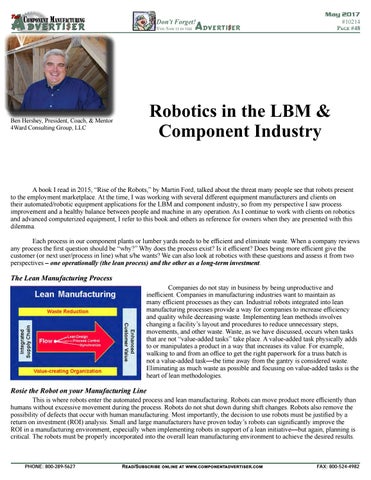A
Th e
Component Manufacturing dverti$er
Adverti$er
Don’t Forget! You Saw it in the
May 2017 #10214 Page #48
Robotics in the LBM & Component Industry
Ben Hershey, President, Coach, & Mentor 4Ward Consulting Group, LLC
A book I read in 2015, “Rise of the Robots,” by Martin Ford, talked about the threat many people see that robots present to the employment marketplace. At the time, I was working with several different equipment manufacturers and clients on their automated/robotic equipment applications for the LBM and component industry, so from my perspective I saw process improvement and a healthy balance between people and machine in any operation. As I continue to work with clients on robotics and advanced computerized equipment, I refer to this book and others as reference for owners when they are presented with this dilemma. Each process in our component plants or lumber yards needs to be efficient and eliminate waste. When a company reviews any process the first question should be “why?” Why does the process exist? Is it efficient? Does being more efficient give the customer (or next user/process in line) what s/he wants? We can also look at robotics with these questions and assess it from two perspectives – one operationally (the lean process) and the other as a long-term investment.
The Lean Manufacturing Process Companies do not stay in business by being unproductive and inefficient. Companies in manufacturing industries want to maintain as many efficient processes as they can. Industrial robots integrated into lean manufacturing processes provide a way for companies to increase efficiency and quality while decreasing waste. Implementing lean methods involves changing a facility’s layout and procedures to reduce unnecessary steps, movements, and other waste. Waste, as we have discussed, occurs when tasks that are not “value-added tasks” take place. A value-added task physically adds to or manipulates a product in a way that increases its value. For example, walking to and from an office to get the right paperwork for a truss batch is not a value-added task—the time away from the gantry is considered waste. Eliminating as much waste as possible and focusing on value-added tasks is the heart of lean methodologies.
Rosie the Robot on your Manufacturing Line This is where robots enter the automated process and lean manufacturing. Robots can move product more efficiently than humans without excessive movement during the process. Robots do not shut down during shift changes. Robots also remove the possibility of defects that occur with human manufacturing. Most importantly, the decision to use robots must be justified by a return on investment (ROI) analysis. Small and large manufacturers have proven today’s robots can significantly improve the ROI in a manufacturing environment, especially when implementing robots in support of a lean initiative—but again, planning is critical. The robots must be properly incorporated into the overall lean manufacturing environment to achieve the desired results.
PHONE: 800-289-5627
Read/Subscribe online at www.componentadvertiser.com
FAX: 800-524-4982
